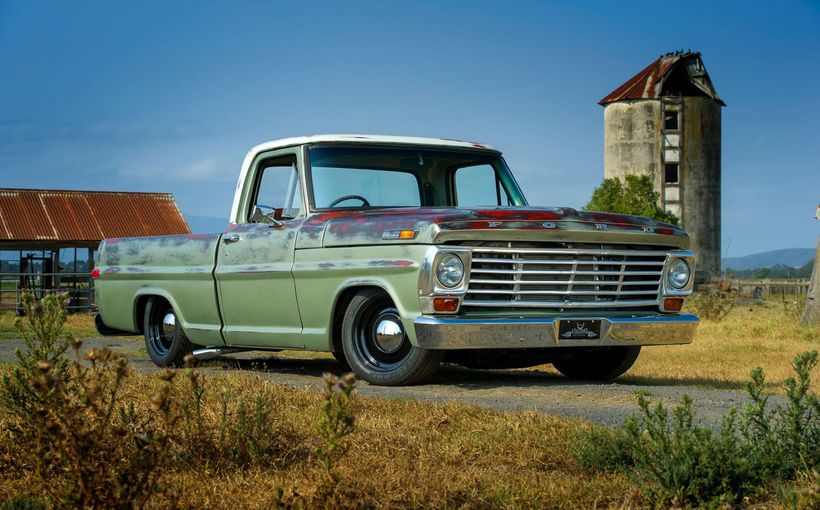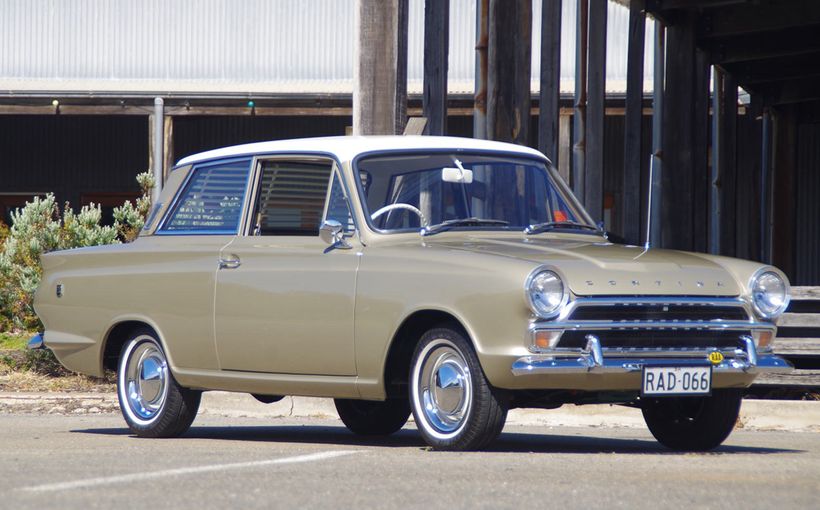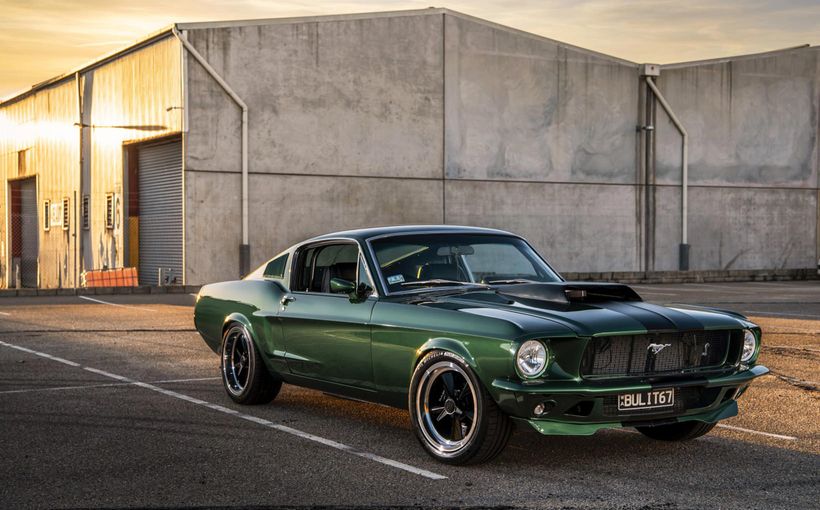Ford Country Squire: the aristocrat of station wagons

“The warmth and elegance of wood had a sophisticated, cultivated appeal,” claims the Automotive Heritage Foundation when reflecting on the late 1930s era. “Station wagons with wooden bodies came to exemplify the epitome of premier craftsmanship, refined grandeur, polished decorum and elegant taste.
“They also denoted wealth and status, since considerable upkeep and near-constant maintenance were required. The annual stripping and revarnishing ritual became part of the woody mystique.”
After Ford released its first all-new post-war model range in 1949, it exploited an aspirational connection between handcrafted wood and the landed gentry by renaming its ‘Custom Deluxe’ station wagon the ‘Country Squire’ in 1950.
Through the eight generations that followed, until its demise in 1991, it remained the top-shelf offering in Ford’s full-size wagon line and always distinguished by its external woodgrain trim.


Image: Ford
It proved so popular that Ford expanded use of the Squire name and woodgrain trim across other model lines, including its all-new compact Falcon range launched in 1960.
As a result, Aussies briefly experienced this US trend when Ford Australia released the XL Falcon Squire in 1962, which remained through subsequent XM and XP models.
Other Ford Motor Company US divisions including Mercury and Edsel, along with Detroit rivals GM, Chrysler and numerous other brands, also adopted the woodgrain station wagon theme in a variety of ways (examples would be most welcome in the Comments section).
Remaining in production for more than four decades, the Country Squire was one of Ford’s longest-running nameplates and one of the most popular and well-known station wagons in automotive history.

Image: Ford
1st Gen (1950-1951)
Ford’s all-new eye-catching wood-trimmed two-door station wagon rode on a 114-inch (2896mm) wheelbase and was marketed as premium family transport.
That was smart thinking given the post-war ‘baby boom’ was well underway in creating a new generation of young Americans, who in their millions would require family car transportation for years to come.
The clever name-change from Custom Deluxe to Country Squire struck a chord with Ford buyers, as more than 83,000 examples found homes before production ceased in 1951.
Unlike Ford’s pre-war ‘woody’ wagons, which had full timber bodies rearward of the firewall, the 1950 version incorporated the greater strength and safety of a steel roof, two-piece tailgate and body architecture by using wood infills to create the external surfaces.

Image: Ford
As a result, the first Country Squire was the only genuine ‘woody’ of the breed, given that it was adorned with genuine dark mahogany veneer with lighter-coloured maple or birch trim. By contrast, its successors all used imitation timber which was not surprising given how labour-intensive this process proved to be, not only in manufacturing but also maintenance for owners.
The Country Squire was equipped with three rows of seating which could accommodate up to eight occupants. The second row could also be folded flat and the third easily removed to create a half-tonne van if more cargo space was required.
Upgrades included heavier duty rear suspension, wider tyres and a larger fuel tank, in response to the Country Squire’s popularity for family vacations.
Its ageing side-valve 'flathead' engine choices were shared with Ford sedans, comprising a standard 226cid (3.7L) inline six and optional 239cid (3.9L) V8. Initially the only transmission was a three-speed manual until a three-speed Ford-O-Matic option arrived in 1951.

Image: Ford
2nd Gen (1952-1954)
Ford redesigned its model line for 1952, with new styling and a small stretch in wheelbase to 115-inches (2921mm) with another half-inch added in 1954.
Station wagons were now produced in two-door and four-door body styles, with the Country Squire’s appeal enhanced with its extra pair of doors. The spare tyre was also moved from the tailgate to under the load floor.
The new Country Squire’s full-steel body was adorned with 3M’s ‘DI-NOC’ vinyl to simulate the dark mahogany side panelling, with its lighter-coloured birch or maple edge-trim now replicated by fiberglass mouldings. This lighter woodgrain effect (also using DI-NOC) extended to the window frames and upper section of the two-piece tailgate.
Numerous body and trim colour choices became available, along with luxurious options like power steering, power brakes and power-adjustable front seats.
In 1954 Ford introduced modern OHV inline six and V8 engines. A new 223cid (3.7-litre) ‘Mileage Maker’ six became the Country Squire’s standard engine, while the new Y-block V8 option shared the same displacement as its flathead predecessor but with increased output.

Image: https://en.wheelsage.org/
3rd Gen (1955-1956)
Facelifted Ford station wagons for 1955 were slightly lower and wider with a new wrap-around ‘panoramic’ windscreen and vertical A-pillars.
The Country Squire’s signature dark woodgrain flanks adopted the appearance of decking found on handcrafted yachts and speedboats. Its lighter-toned fiberglass edge-trim included ‘spears’ that extended along the front fenders.
The ever-expanding list of Country Squire options added power windows and air-conditioning, along with safety enhancements including seat-belts (!), padded dashboards and more.
In 1956 the Country Squire (like all new Fords) got another facelift and an upgraded 12-volt electrical system to cope with the increasing number of electrically-powered options.
That year the premium Crestline sedan was discontinued, with the Country Squire becoming the station wagon equivalent of the new Fairlane that replaced it. Country Squire buyers could now choose from several Y-block V8 options up to a 312cid (5.1-litre) variant.

Image: https://en.wheelsage.org/
4th Gen (1957-1959)
A complete redesign of the Ford model range brought longer, wider and lower styling in line with Detroit’s latest trends.
Reducing the height required a drop in wheel diameter from 15 to 14-inches and a new perimeter-frame chassis that allowed the floor-pan to sit between the frame-rails, rather than above them like previous truck-style ‘ladder’ frames.
At launch the latest Country Squire rode on a longer 116-inch (2946mm) wheelbase and featured numerous styling influences from the latest Ford Thunderbird coupe including tailfins, large round taillights and forward-leaning ‘dogleg’ A-pillars that accentuated the wraparound windscreen.
The Country Squire’s larger dimensions could for the first time accommodate up to nine occupants. Pneumatic rear suspension, designed to maintain a level ride height under heavy loads, was added to the options list.

Image: Ford
The 1958 Ford facelift brought four headlights and oval-shaped taillights. A new three-speed Cruise-O-Matic transmission was introduced along with a new FE (Ford-Edsel) V8 engine family, initially in a choice of 332cid (5.4L) or premium 352cid (5.8L) variants.
1959 brought the third redesign of the Ford model line in as many years (a process of annual obsolescence perfected by Detroit) with the Country Squire benefitting from another stretch in wheelbase to 118-inches (2997mm) and more than five inches added to its length.
The simulated birch or maple effect on the roof pillars of previous Country Squires was replaced by sparkling stainless-steel trim.

Image: Ford
5th Gen (1960-1964)
The full-size Ford model line was completely redesigned for 1960, maintaining a traditional body-on-frame structure but with a longer 119-inch (3023mm) wheelbase and new styling that was even longer, wider and lower.
The new Galaxie replaced the Fairlane as Ford’s premium full-size offering, resulting in the Country Squire becoming the station wagon equivalent with its signature woodgrain sides and tailgate continuing the yacht-decking theme.
At launch the Country Squire was available with a standard inline six and three optional V8s, joined in 1962 by the new FE 390cid (6.4L) big block V8. A new ‘Windsor’ small-block V8 followed in 1963, initially in 260cid (4.2L) displacement which increased to 289cid (4.7L) the following year.
A substantial redesign for 1961 featured more styling influence from the latest Thunderbird, as evidenced by its tailfins and round taillights. Ford wagons also featured a new one-piece tailgate which housed window glass that could be lowered and raised.

Image: Ford
6th Gen (1965-1968)
The full-size Ford range was again redesigned for 1965, with ultra-clean styling highlighted by straight character lines, large rectangular taillights and a new front-end design with vertically-stacked headlights and an imposing full-width grille.
A new LTD grade became the flagship of the Galaxie fleet, ensuring that the latest Country Squire was assigned as the LTD’s station wagon equivalent, sharing its luxurious interior trim.
A clever new seating option replaced the forward-facing third row with bench seats mounted along each side of the cargo area that faced the centre.
This not only gave the Country Squire an unprecedent 10-seat capacity. It also kept kids entertained during long trips (no iPhones or iPads in those days) thanks to a foldable metal table between the seats, which was equipped with a checkers (aka draughts) gameboard and magnetic checker pieces that would stay in place while the vehicle was moving.
This seat/table combo could easily fold away to create a large cargo area when required, remaining a popular option until the end of Country Squire production.

Image: Ford
The mildly facelifted 1966 Country Squire launched the innovative ‘Magic Doorgate’ two-way tailgate (shared with all full-size Ford wagons) that folded flat in the traditional way but could also swing open like a door to enhance rear passenger access.
The sixth-generation Country Squire offered a variety of drivetrains with a new 240cid (3.9L) ‘Big Six’ standard engine introduced in 1965, followed in 1966 by optional two and four-barrel versions of the 390 V8 and for the first time a whopping 428cid (7.0L) V8.

Image: Ford
In 1968 the Country Squire had a significant styling update with adoption of the LTD’s bonnet badging and split-grille with headlights concealed by vacuum-operated covers.
This generation also saw the 289 V8 expanded to 302cid (4.9L) and new three-speed autos were introduced comprising the C4 for sixes and small V8s, FMX for medium-sized engines and C6 for large V8s.

Image: Ford
7th Gen (1969-1978)
A redesign of full-size Fords for 1969 saw another increase in wheelbase to an expansive 121-inches (3073mm) and the wagon’s two-way tailgate was updated to a three-way design that could now fold flat or swing open with the window lowered or raised (it previously had to be lowered for these movements).
The Country Squire continued to be aligned with the premium LTD sedan, sharing its sumptuous interior trim and classy concealed-headlight grille while maintaining its unique woodgrain side and rear trim. An extensive restyle for 1971, though, saw it lose the concealed headlights.
Initially the Country Squire’s standard engine was a 302 V8 which was soon replaced by a larger 351cid (5.8L) V8. As with the LTD sedan, 390 and 429 V8s were optional, but the 390 was replaced by a 400cid (6.6L) V8 in 1971 which was joined in 1972 by a gargantuan 460cid (7.5L) V8.

Image: Ford
These big gains in engine size were in response to increasing kerb weights and diminishing power outputs, the latter largely resulting from introduction of lower octane unleaded gasoline. Published engine power ratings also dropped considerably at this time, due to an industry switch to SAE Net measurement.
The Country Squire gained even more weight and length in 1973 with the addition of federal-mandated 5mph impact-absorbing front bumpers, which were joined the following year by similar rear bumpers. This ensured the 1974 models were the longest Country Squires ever built by Ford, spanning more than 5.7 metres. And the heaviest, with kerb weights now exceeding 2.2 tonnes!
From 1975 to 1978 there were only minor trim and cosmetic changes for the Country Squire, including the return of concealed headlights shared with the premium LTD Landau coupe.

Image: Ford
8th Gen (1979-1991)
At the pre-dawn of a new energy-conscious decade, Ford’s full-size range was downsized for 1979. The Country Squire went back to the future by adopting a compact 114-inch (2896mm) wheelbase (identical to the 1950 original) along with trimming almost 300mm from its length and about half a tonne from its kerb weight.
Even so, it still offered three rows of seating with only a small drop in cargo volume. These size and weight reductions also allowed a return to smaller 302 and 351 V8s, with the 302 being upgraded with electronic fuel injection.

Image: https://en.wheelsage.org/
However, the Country Squire’s glory days were behind it as sales of full-size station wagons went into terminal decline in the 1980s, perceived as old-fashioned by family buyers who opted for more modern and efficient alternatives like minivans and SUVs.
By 1991, the Country Squire had reportedly become the slowest-selling Ford model in the US, with less than 4000 units sold. It was quietly discontinued and with that decision more than four decades of woodgrain wagon production added another colourful chapter to Ford’s history books.








